
Vol. XXV, No. 5, May 2025
- Editor's corner
- Consumer expenditures for out-of-home entertainment and recreation not keeping up with inflation
- A paradigmatic shift for LBEs; the entertainment is no longer the primary attraction
- Gen Zers have global palettes
- Novelty seeking; the decline of repeat appeal
- As if arcade games aren't already large, welcome to the Human Crane
- If your entertainment venue isn't experiencing valueflation, it's probably losing ground
- The growing number of amusement and theme parks
- Saving clients from themselves
If your entertainment venue isn't experiencing valueflation, it's probably losing ground
Location-based entertainment and sports venues are all in the business of selling time well spent, where what people buy is the time they spend engaged at the venue.
A good way to measure the value of time well spent is the money value of time* (MVT). MVT recognizes that the amount of money customers willingly pay for any experience is directly proportional to the value they receive for the time they spend there. MVT allows an experience venue charging an admission fee, membership fee, or some other way of charging the customer to measure itself against other experiences using the MVT scale of expenditure per minute.
A blockbuster film at a cinema usually lasts about 2 hours and costs $16 for a Saturday evening viewing. We value the time spent watching the movie at 13.3 cents a minute. But if we see it on an IMAX screen, the ticket might cost $24 or an MVT of 20 cents a minute. We consider the IMAX viewing experience at a 50% higher value for time well spent, so we will pay more for it.
The average standard adult admission price for a one-day ticket to the Magic Kingdom at Walt Disney World in 2025 is approximately $180, and this doesn't include the premium prices people pay for food and drinks while there. People typically spend around 10 hours in the park, so the MVT is 30 cents per minute. People value their time at the Magic Kingdom more than twice the value of attending a blockbuster movie on a regular cinema screen. Due to the Magic Kingdom's high perceived value, they will spend an entire day there.
Other examples of out-of-home experiences with high MVTs include:
- National Football League (NFL) games - the average 2024 ticket price was $132, and the average game length was 3 hours and 12 minutes, resulting in an MVT of 69 cents per minute. The 2024 Super Bowl had a much higher MVT - $18.29 per minute for the average face-value ticket sold by the NFL and $34.96 per minute for the average resale ticket price.
- Music concerts - the average price in the U.S. of the top 100 worldwide music concerts was $136. Assuming a longer concert of three hours results in an MVT of 75.5 cents per minute. Many concerts had much higher MVTs. In 2024, most attendees had to pay resale prices for Taylor Swift's "Eras Tour" concerts in the U.S., resulting in an average MVT of $14.36 per minute.
The best way to increase revenues at an experience venue is to increase its MVT, its price. This requires raising the fidelity and the perceived value of the experience, improving its quality, memorability, and uniqueness. When you raise the MVT, you also create a competitive advantage over peoples' other experience venue options.
Attractions like the Magic Kingdom are staying highly competitive by raising their money value of time faster than inflation. This is the valueflation concept introduced by Joe Pine. Valueflation describes a phenomenon distinct from traditional inflation. While inflation typically refers to rising prices driven by increased costs of production (such as labor or materials) or demand exceeding supply, valueflation refers to rising prices driven by a greater value consumers place on specific experiences relative to others.
The Magic Kingdom at Disney World is an excellent example of valueflation. Its average regular one-day adult admission price has, with few exceptions, increased in price every year at a greater rate than inflation. From 2000 to 2024, the admission price to the Magic Kingdom increased 224%, almost three times the 81% increase in inflation. And even with such significant price increases, attendance grew from 15.4 million in 2000 to 18.0 million in 2024.
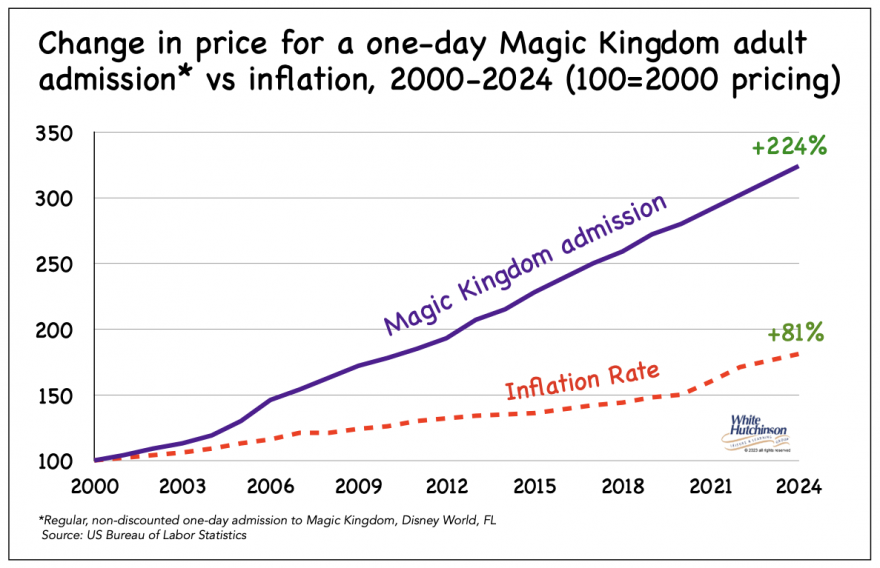
From 2000 to 2004, Universal Studios also experienced valueflation, with its admission price increasing by 224%. However, not all theme parks experienced valueflation. Six Flag's average admission price only increased by 54% since 2000, far less than the 81% inflation rate, and their legacy park attendance was flat.
Three other examples with nearly consistent annual valueflation from 2000 to 2024 are:
- The top 100 worldwide concert tours where the average admission price increased by 232%, with U.S. attendance growing by 36%.
- Prices for the top 10 U.S. music concerts increased by 97% on average, with attendance growing by 78%.
- Average prices for admission to all sporting events rose 120%.
- National Football League games saw an average 230% price increase with a 13% total annual attendance increase.
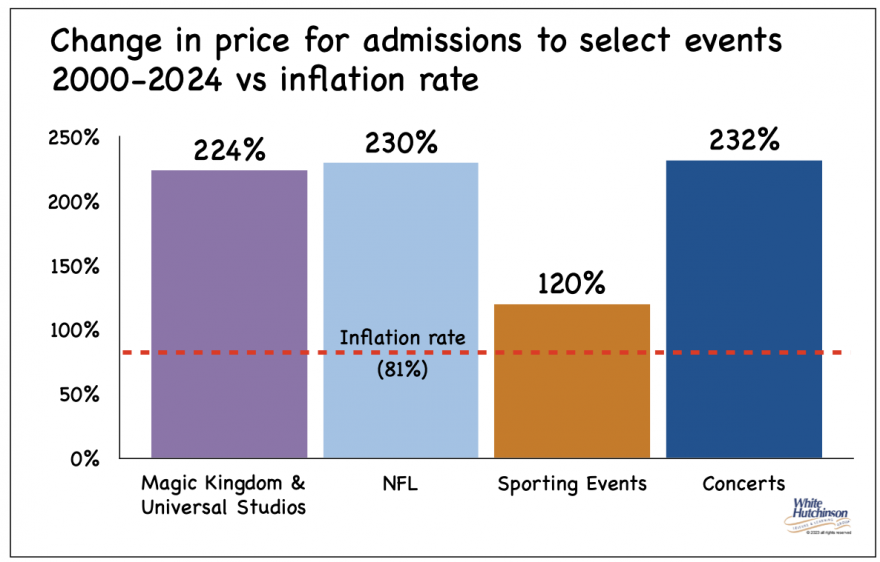
Out-of-home experiences with high MVT and which consistently achieve valueflation are the cream of the crop, the top-notch attractions. They not only achieve annual admission price increases greater than inflation, but they also consistently grow their attendance.
Americans generally say their time is either more or equally important as money, according to a recent CivicScience poll. Four-in-10 Americans (42%) value time over money, while 46% value it equally. Only 13% value money over time.
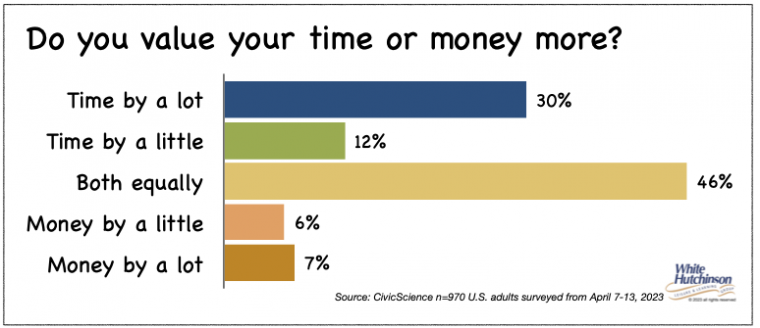
The monetary value of time is greater for people with higher socioeconomic status than those with lower socioeconomic status. The reason is that people from higher socioeconomic households have the least leisure time (74 minutes less a day than a high school graduate), meaning they will definitely want to avoid wasting it, making time well spent even more valuable. This large market of customers can afford and are willing to pay higher MVTs.
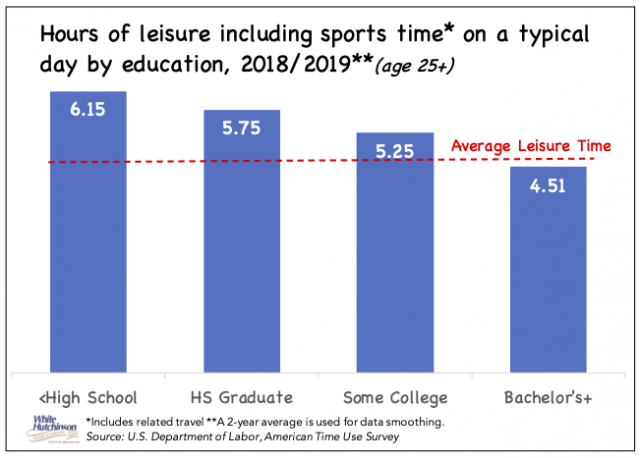
A recent CivicScience poll found that the pandemic increased the value of time for many people. Three in ten Americans now say that time is more important than before the pandemic (30%), while fewer say that money is more important (13%). For 57%, their values have stayed the same from pre-pandemic years.
Nearly half of those who are now financially better off than before the pandemic (49%) and 42% who are financially the same say time is now more important to them. Even over one-third of those worse off financially (37%) say time is now more important to them. The wealthier people are, the more they value time over money.
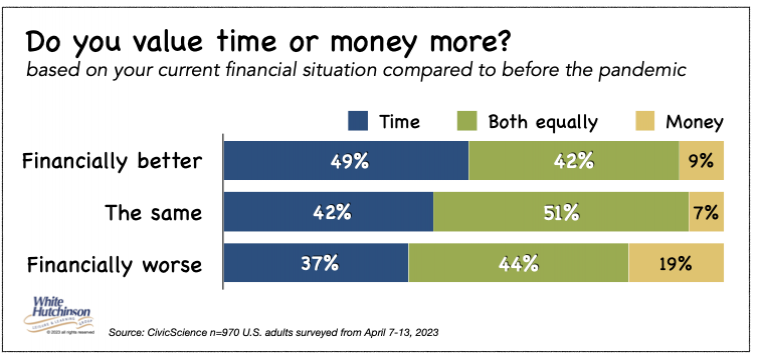
With time so valuable to them, higher socioeconomic households seek out high MVT experiences to ensure their time is well spent and not wasted. They are the prime market for out-of-home entertainment and sports venues. In 2023, 80% of all spending on fees and admissions to entertainment and art venues was by the 45% of all households with a person with a bachelor's degree or higher. Their average entertainment and art spending for fees and admissions was more than six times what high school graduate households spent. Bachelor's+ households accounted for 81.5% of all admission fees for sports events.
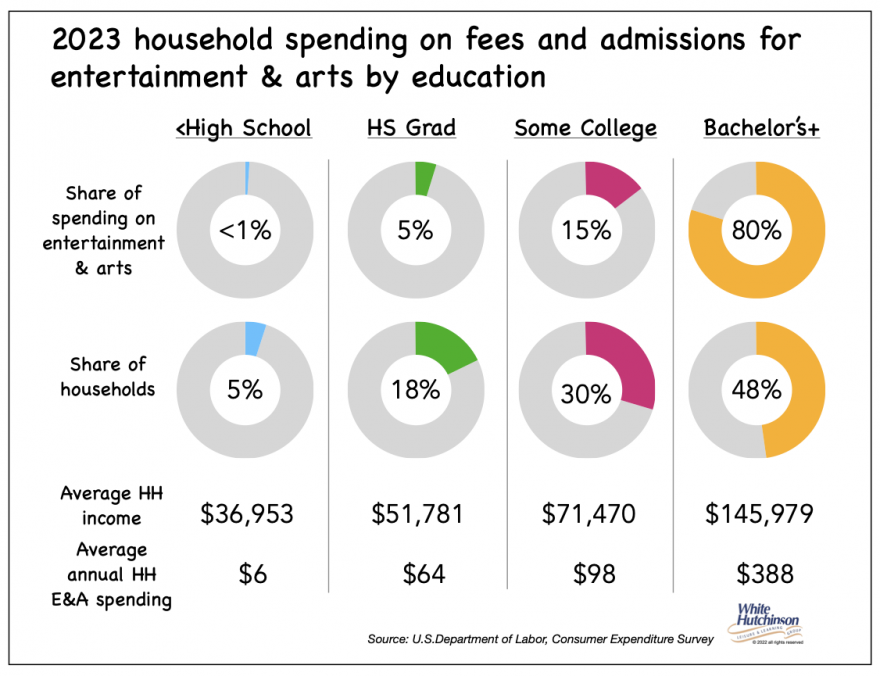
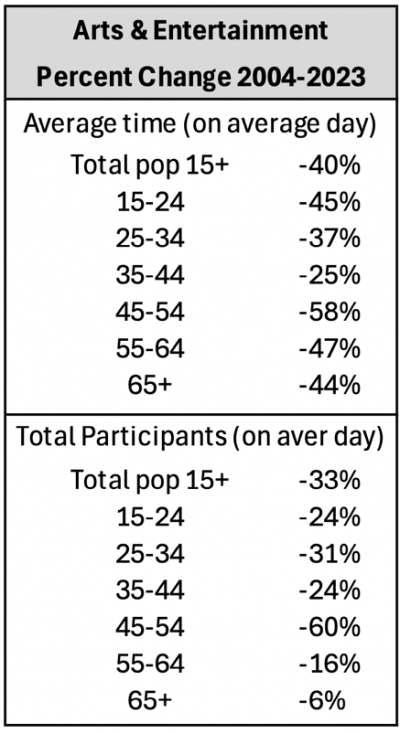
The opportunity to stand out from the crowded out-of-home entertainment venue market with a top-notch valueflation venue is wide open. Today, more people value time over money than in the past. The higher socioeconomic, the most educated, with the least leisure time who most prioritize time, can most afford and are more than willing to pay for expensive premium top-notch experiences that offer highly valued time well spent.
Top-notch valueflation venues with price increases outpacing inflation have a competitive advantage. They are slowly taking market share away from other entertainment venues, including family entertainment centers. The issue is that the out-of-home entertainment market is shrinking in spending and participation. The average household spending on out-of-home entertainment and arts was 15% less in 2023 than in 2000 (inflation-adjusted). The number of people participating in OOH entertainment and arts on an average day has decreased by one-third (-33%) since 2004, resulting in the average person spending less time on an average day at an entertainment and arts venue. So, the pie has gotten smaller in dollars and time while the size of the slice top-notch valueflation venues has increased, so they are getting a larger percentage of the pie than in earlier years.
Meanwhile, households are spending more on admissions to sports events, up 20% since 2000 (inflation-adjusted) due to their valueflation price increase.
Contributing to the shrinking market share of most entertainment and art venues is that the continually improving top-notch venues are constantly raising people's expectations, reducing the attractiveness of other venues that do not enhance their perceived value as much.
To join the select group of top-notch high MVT valueflation out-of-home experiences requires:
- Making the experience authentic and distinct from what competitors offer, making it irreplaceable and justifying premium pricing.
- Designing every aspect of the customer journey to maximize engagement, enjoyment, and emotional resonance, ensuring attendees feel their time was exceptionally well spent.
- Consistently innovating, updating, and refreshing offerings by investing in quality, service, and unique features that enhance the overall experience to maintain this differentiation and increase its perceived value for time well spent.
Subscribe to monthly Leisure eNewsletter
Vol. XXV, No. 5, May 2025
- Editor's corner
- Consumer expenditures for out-of-home entertainment and recreation not keeping up with inflation
- A paradigmatic shift for LBEs; the entertainment is no longer the primary attraction
- Gen Zers have global palettes
- Novelty seeking; the decline of repeat appeal
- As if arcade games aren't already large, welcome to the Human Crane
- If your entertainment venue isn't experiencing valueflation, it's probably losing ground
- The growing number of amusement and theme parks
- Saving clients from themselves


